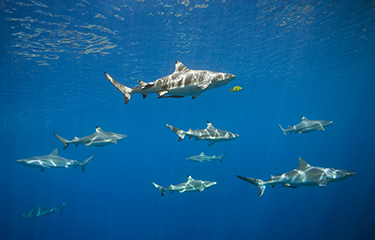The listing of blue sharks by a body that regulates trade in endangered species will add a layer of paperwork for Japanese shark-product exporters.
The port of Kesennuma, Japan, located in the northeast of Japan’s main island of Honshu, is the main center for shark fishing and processing in Japan. Large numbers of shortfin mako and blue sharks are landed there annually, to be turned into gelatinous shark fin soup and fluffy white “hanpen” fishcake for the domestic market. The meat is also exported, mainly to South America, Spain, South Korea and Taiwan, while dried fins are sent to China via Hong Kong.
Kesennuma leads the nation in shark landings, and though local shark populations are not endangered, two of its top-traded species, shortfin mako shark and blue shark, are now subject to more-complicated export rules. Both shortfin and longfin mako sharks were included among 18 species of sharks that were given Appendix II listing at the 2019 CITES conference, while blue sharks were added to the same list at the 2022 meeting.
The Convention on International Trade in Endangered Species of Wild Fauna and Flora (CITES), which is also referred to as the “Washington Convention,” is a multilateral treaty to protect endangered plants and animals. Appendices I, II, and III to the convention are lists of species afforded different levels of protection. Appendix II is for species that are not threatened but may become so unless trade is regulated.
The 19th Conference of the Parties to the Convention (COP19) met in Panama City from 14 to 25 November, 2022, where it decided to add 95 species of sharks and guitarfish to Appendix II. Among them were 54 species of requiem sharks, including the blue shark (Prionace glauca).
For species listed in Appendix II, CITES parties can still allow trade if they certify that it is not detrimental to the survival of the species in the wild (known as a non-detriment finding, or NDF). Japan’s current catch of blue sharks within its own exclusive economic zone likely meets this criteria, but landing catches from outside its EEZ could require import permission under CITES rules, which might cause delays in processing. Sharks caught by distant-water fleets might not qualify.
Japan's National Plan of Action for Conservation and Management of Sharks, originally issued in 2001 and updated in 2016, lists the offshore longline fishing fleet based on Kesennuma as one of the major offshore longline fleets in Japan. The fleet mainly operates in the transition zone between the Oyashio and Kuroshio currents, in the subtropical and temperate northwest Pacific throughout year. Blue shark is one of its primary target species, and they generally target blue sharks from early summer to early autumn.
In the report titled, “Update of Japanese annual catches for blue shark caught by Japanese offshore and distant-water longliner in the North Pacific Ocean from 1994 to 2018,” author Mikihiko Kai estimates Japan’s annual catch of blue sharks in the North Pacific, including bycatch of the longline tuna fishing industry, at 5,000 metric tons annually, while an equal amount was brought to Japan from the distant-water fishery. Japan's shark-fishing effort has decreased in recent years, and its the catch per unit effort has increased, Kai found.
“The results also suggested that the abundance of blue shark in the central and western North Pacific has been increasing since 2009,” he wrote.
The International Union of Concerned Scientists (IUCN) Red List shows that the North and South Atlantic blue shark populations are endangered and vulnerable, respectively, while those of the North and South Pacific and the Indian Ocean are ranked as species of least concern.
Photo courtesy of cbpix/Shutterstock







